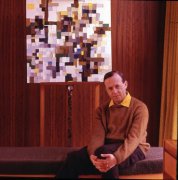

Press Release
Bernat Klein A LIFE IN COLOUR
A Life in Colour is a retrospective exhibition featuring tapestries and paintings by the textile designer
and artist Bernat Klein at Dovecot Gallery from 31 July to 26 September 2015.
Serbian-born Bernat Klein CBE (1922-2014) studied textile technology at Leeds University Textile
Department until 1948, after which he embarked upon a career designing woven textiles leading him
to Edinburgh to work for Munrospun. In 1950 the company relocated to the Scottish Borders and
two years later Klein established his own luxury textile enterprise, Colourcraft.
Architect Peter Womersley was commissioned to modernise Colourcraft’s Netherdale Mill at
Galashiels, and to design the award winning modernist house and studio at High Sunderland near
Selkirk, where Klein remained until the end of his life. The A listed studio building is now privately
owned but is registered at risk with flood damage having halted progress to redevelop the property
into flats. The subject of Klein supporters, emerging artists and architects alike, the modernist studio
and house attracts much interest today. Many have championed to have the High Sunderland
buildings restored and have depicted them as subjects for their own work; notably Toby Paterson
and most recently Andrew Mackenzie. Bernat Klein’s daughter Shelley Klein resides at the house,
and has worked closely with Dovecot to realise this exhibition in memory of her late father.
Klein’s signature vibrant mohair and tweed textiles were produced in the Scottish Borders for
fashion houses in Europe until the 1980s when production was sought elsewhere in the Far East.
Klein’s commercial success can be attributed to his artistic flair for colour and texture, which won
him ultimate acclaim amongst the fashion editors of publications including Vogue and Elle. As a
reaction to the utilitarian and earthy colour schemes of 1950s Scottish fashion and interior textiles,
colourist Klein embraced a bright new palette inspired by his natural surroundings. From his own
Pointillist inspired oil paintings and designs for Chanel, Dior and Yves Saint Laurent fabrics, to the
sumptuous furnishings and floral printed fashion synthetics, seen in the iconic glamour photography
of the 60s and 70s, colour technology was at the heart of Klein’s practice.
This eye for colour and design was applied to a variety of media by Klein, as illustrated in this
exhibition of works spanning five decades, and including tapestries created in collaboration with the
Dovecot weavers in 1971. From a suite of 10 tapestries, three including Highland Pool are part of
the National Museums of Scotland Bernat Klein collection, Sea and Sky was sold at a Christie’s
auction in 1994 in Glasgow and five of the remaining will be made available for sale during A Life in
Colour. The tapestries directly emulate the deeply folding creases of Klein’s painted works,
examples of which will also appear in the exhibition. In other works, Klein incorporates his own
woven and polyester fabrics. Provencal Scarlet is a bold collage of thickly applied paint, interwoven
with rich pink and velvet ribbon - the Chanel fabrics seen on the catwalks of Paris in 1968.
Dovecot Gallery is proud to present this exhibition in recognition of the lasting contribution Klein
made to Scotland’s international reputation for textile design and making.
-Ends-
Exhibition open: 31 July to 26 September 2015 Private view: Thursday 30 July 6-8pm
This exhibition at Dovecot Gallery is part of Edinburgh Art Festival and supported by Dovecot
Foundation. Check website for opening times www.dovecotstudios.com
Exhibition open to the public:
Daily 10-6pm 31 July to 31 August | Mon-Sat 10.30am-5.30pm 1-26 September
Book for associated events at www.dovecotstudios.com
Event programme in association with Edinburgh Art Festival
For further details check www.dovecotstudios.com and www.edinburghartfestival.com
Interviews may be conducted with Bernat Klein’s daughter Shelley Klein at the High Sunderland
house. To arrange an appointment email lizziecowan@dovecotstudios.com
Press release image credit:
Bernat Klein at High Sunderland, circa 1960s, courtesy Bernat Klein Trust
More images here:
https://www.dropbox.com/sh/muh7ymgmlljgkgb/AACgTcs1zx1qqDuJsJSqYf5xa?dl=0
For press information and further images: Lizzie Cowan, Marketing Coordinator
Dovecot Studios lizziecowan@dovecotstudios.com T:0131 550 3660 W:www.dovecotstudios.com
Dovecot Studios 10 Infirmary Street, Edinburgh, EH1 1LT.
About Bernat Klein
Klein was born in Senta, in what was then Yugoslavia. In 1940 he attended the Bezalel Academy of
Arts and Design, Jerusalem, and then moved on to the University of Leeds, England, where he
studied textile technology from 1945. He was employed by various textile companies in England and
Scotland, until 1952 when he established Colourcraft (Gala) Ltd. This comprised a weaving centre
in Galashiels in the Scottish Borders, producing rugs and other items which were sold at the
company's own shop in Edinburgh. He created innovative textiles, building up trade with producers
such as Marks and Spencer.
In 1962, Coco Chanel chose Klein's fabrics for her spring collection, which led to greater exposure
and further sales to couture houses in the US and Europe including Dior, Balenciaga, Pierre
Cardin and Saint Laurent. The company was renamed Bernat Klein Limited, and a major stake in the
business was acquired by a subsidiary of Imperial Tobacco.
Klein resigned from this company in 1966, setting up on his own again. He based himself at his home
near Selkirk, where he commissioned a studio building from the architect Peter Womersley, who had
designed Klein's house, High Sunderland, in the 1950s. He established a cottage industry of hand-
knitters, employing up to 250 people. During the 1970s he began producing his own clothing
collections, and later established himself as a design and colour consultant. The Department of the
Environment commissioned him in the latter capacity to develop standard ranges of carpets and
upholstery fabrics.
Klein drew inspiration from nature for his textiles and paintings. His signature fabrics include
colourful exotic tweeds, incorporating mohair and ribbons, as well as velvet and jersey fabrics. He
won the Design Council Award in 1968, was appointed CBE in 1973 and awarded an honorary
degree from Heriot-Watt University in 2003. Bernat Klein died 17 April 2014.
Copy of biography from: Bernat Klein Textile Designer, Artist, Colourist, Bernat Klein and Lesley
Jackson, Bernat Klein Trust, 2005 © 2005 Bernat Klein Trust and Lesley Jackson ISBN 0-9541979-2-5
can be viewed here: https://www.dropbox.com/s/x3mxfp91tg5ucc3/BERNAT_KLEIN_BIOG.pdf?dl=0
Klein was made an honorary member of the Royal Incorporation of Architects Scotland because of
his design skills. Rias secretary Neil Baxter described him as “an adoptive Scot whose international
influence as a textile designer cannot be underestimated. As an entrepreneur he helped revitalise
the Border’s weaving and cloth manufacturing industries. Working alongside the glitterati of 20th-
century fashion, several of whom were personal friends, Klein gave Scottish textiles a new cachet
and was largely responsible for the introduction of tweed to the catwalks of Paris and Milan. For a
generation of Scottish women, owning a Bernat Klein creation was an aspiration.” Scotsman
Publications, obituary by Jeremy Watson, 20 Sunday April 2015
About Dovecot Studios
Dovecot Gallery
Dovecot Gallery is a landmark centre for contemporary art, craft and design built around a leading
international tapestry studio. Occupying an extraordinary building in the heart of Edinburgh, the
Gallery works to programme, commission and produce exhibitions and events for audiences and
clients who share Dovecot’s passion for making and the creative arts.
Dovecot Tapestry Studio
Dovecot Tapestry Studio is a world-renowned producer of hand-woven tapestry and gun-tufted rugs.
Continuing a century-long heritage of making and collaboration with leading international
contemporary artists, the Studio weavers are dedicated to producing extraordinary and engaging
works of art by commission from private and public collectors from across the globe.
Dovecot Foundation
Dovecot Foundation exists to champion Dovecot Tapestry Studio and its place in the world of
contemporary art, design and making. The Foundation puts the Studio at the heart of this mission in
supporting the Dovecot Apprenticeship Programme, collaborations with leading artists from around
the world and development of cultural and educational partnerships. Ultimately, the Foundation
seeks to bring the innovative work of contemporary artists and makers to a wider audience.
History
Dovecot Studios was founded in 1912 by the Marquess of Bute, a patron of the arts. The first
weavers at Dovecot, Gordon Berry and John Glassbrook, came from the renowned William Morris
Studios at Merton Abbey in Wimbledon. Dovecot’s first commission was for a series of monumental
tapestries for the Marquess’ own home at Mount Stuart on the Isle of Bute.
In 1946, the Studios were incorporated as The Edinburgh Tapestry Company. Dovecot soon became
established as a leading contemporary fine art tapestry studio, with works commissioned for major
public, corporate and academic institutions worldwide. As a key player in the renaissance of tapestry
in the 20th century, Dovecot’s Master Weavers worked with many leading contemporary artists
including David Hockney, Henry Moore, Frank Stella and RB Kitaj.
Dovecot’s Master Weavers continue to work to commission, producing tapestry and tufted rugs for
private and public collectors. Major tapestry projects include Alison Watt’s Butterfly for Scottish
Opera’s new Theatre Royal, Peter Saville’s Monarch of the Glen and Magne Furuholmen’s Glass
Onion. Working with artists such as Ron Arad, Linder Sterling and Garry Fabian Miller on recent rug
commissions have further tested the boundaries of creativity and play with what the process allows.